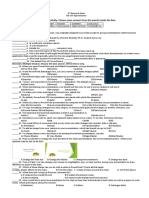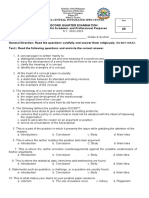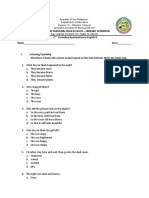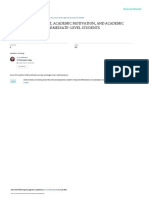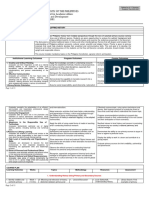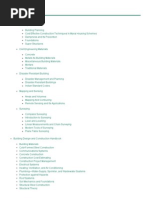Department of Education: English 10: 2 Summative Test
Department of Education: English 10: 2 Summative Test
Uploaded by
Richard Bryan BuenaflorCopyright:
Available Formats
Department of Education: English 10: 2 Summative Test
Department of Education: English 10: 2 Summative Test
Uploaded by
Richard Bryan BuenaflorOriginal Description:
Original Title
Copyright
Available Formats
Share this document
Did you find this document useful?
Is this content inappropriate?
Copyright:
Available Formats
Department of Education: English 10: 2 Summative Test
Department of Education: English 10: 2 Summative Test
Uploaded by
Richard Bryan BuenaflorCopyright:
Available Formats
Republic of the Philippines
Department of Education
REGION 1 – ILOCOS REGION
SCHOOLS DIVISION OF ALAMINOS CITY
PANGAPISAN INTEGRATED SCHOOL
PANGAPISAN, ALAMINOS CITY, PANGASINAN
ENGLISH 10: 2nd SUMMATIVE TEST
NAME______________________________________________________Score:___________
Grade and Section: _____________________________
General Directions: Read the following items mindfully. Then answer each completely and correctly to
the best of your ability. Write the letter of the correct answer on the space provided.
______1. It emphasizes the connection between the different concepts. This is called the most beneficial
organizer.
A. Cause & Effect Diagram C. Venn Diagram
B. Flow Diagram D. Concept Maps
______2. It is a sequence chart that shows series of events in order.
A. Cause & Effect Diagram C. Venn Diagram
B. Flow Diagram D. Graphic Organizers
______3. This is used to identify, classify, categorize and recognize similarities and differences of two or more
subjects, ideas, thoughts, and / or concepts.
A. Cause & Effect Diagram C. Venn Diagram
B. Flow Diagram D. Concept Maps
______4. These textual aids actually provide learners with structure for abstract concepts.
A. Cause & Effect Diagram C. Venn Diagram
B. Flow Diagram D. Graphic Organizers
______5. These are general organizers or textual aids that can show the central thought with its matching
characteristics.
A. Cause & Effect Diagram C. Venn Diagram
B. Flow Diagram D. Concept Maps
______6. The time and location in which a story takes place.
A. Plot B. Setting C. Conflict D. Characterization
______7. Don`t judge a book by its cover is an example of _____________.
A. Mood B. Theme C. Setting D. Conflict
______8. The angle where the story is told.
A. Camera view B. Character view C. Point of view D. None of the above
______9. The central, main character of a story is called
A. Protagonist B. Instigator C. Investigator D. Antagonist
______10. The opposition of forces, essential to the plot is called _____________?
A. Character B. Setting C. Climax D. Conflict
______11. The most exciting part of the story is called___________.
A. Exposition B. Setting C. Rising Action D. Climax
______12. What is the sequence of events involving characters and a central conflict called?
A. Setting B. Plot C. Conflict D. Character
______13. All events after the climax and leading to the resolution:
A. Rising Action B. Falling Action C. Exposition D. Climax
______14. End of central conflict:
A. Resolution B. Falling Action C. Exposition D. Climax
______15. This is where the settings and the characters are introduced.
A. Exposition B. Setting C. Rising Action D. Climax
PANGAPISAN INTEGRATED SCHOOL
PANGAPISAN, ALAMINOS CITY,PANGASINAN
500564@deped.gov.ph
Republic of the Philippines
Department of Education
REGION 1 – ILOCOS REGION
SCHOOLS DIVISION OF ALAMINOS CITY
PANGAPISAN INTEGRATED SCHOOL
PANGAPISAN, ALAMINOS CITY, PANGASINAN
ENGLISH 10: 3rd SUMMATIVE TEST
NAME______________________________________________________________Score:___________
Grade and Section: _____________________________
General Directions: Read the following items mindfully. Then answer each completely and
correctly to the best of your ability. Write the letter of the correct answer on the space
provided.
______1. Evaluating information is important in the research process because..?
A. Sources vary in the levels of authority, accuracy and objectivity
B. Not all information is suitable for your paper
C. All information available to us is reliable
D. "Fake news" is widespread
______2. The following are example of primary sources, except
A. Movie reviews B. Legal documents C. Pieces of creative writing D. Interview
______3. What should you look for in a reliable website?
A. Recent Updates B. Well laid out design C. Unattractive graphics D.Working links
______4. Unofficial sites can be inaccurate. Is the statement true or false?
A. true B. false C. maybe D. neither
______5. Anything that supplies information is a?
A. works cited B. database C. reliable D. source
______6.. Sources created by people not directly involved in the events they describe are?
A. plagiarism B. database C. primary source D. secondary source
______7. Sources created by people who witnesses or took part in the events they describe are?
A. primary source B. database C. secondary source D. index
______8.Your Science teacher is teaching the class about force and vectors. What type of listening to be used
in the given situation?
A. Appreciative B. Comprehensive C.Empathic D.Critical
______9. You are in a Poetry Interpretation Contest during Book Month. What type of listening to be used in
the given situation?
A. Appreciative B. Comprehensive C.Empathic D.Critical
______10. Your friend is ranting about his/her problems.What type of listening to be used in the given
situation?
A. Appreciative B. Comprehensive C.Empathic D.Critical
______11. An item is being sold at O Shopping.What type of listening to be used in the given situation?
A. Appreciative B. Comprehensive C.Empathic D.Critical
______12 A You Tube video tutorial is being shown.What type of listening to be used in the given situation?
A. Appreciative B. Comprehensive C.Empathic D.Critical
______13. Analytical listening enables the listener to establish relationships between and among items in a
given text. Is this statement correct or incorrect?
A. Correct B. Incorrect C. Maybe D. Neither
______14. Analytical listening is a type of critical listening.Is this statement correct or incorrect?
A. Correct B. Incorrect C. Maybe D. Neither
______15. Analytical listening is listening to evaluate a message for the purposes of accepting or rejecting it. Is
this statement correct or incorrect?
A. Correct B. Incorrect C. Maybe D. Neither
PANGAPISAN INTEGRATED SCHOOL
PANGAPISAN, ALAMINOS CITY,PANGASINAN
500564@deped.gov.ph
Republic of the Philippines
Department of Education
REGION 1 – ILOCOS REGION
SCHOOLS DIVISION OF ALAMINOS CITY
PANGAPISAN INTEGRATED SCHOOL
PANGAPISAN, ALAMINOS CITY, PANGASINAN
ENGLISH 10: 4th SUMMATIVE TEST
NAME___________________________________________________________Score:___________
Grade and Section: _____________________________
General Directions: Read the following items mindfully. Then answer each completely and
correctly to the best of your ability. Write the letter of the correct answer on the space
provided.
______1. This refers to a person’s opinion of something based on a set of criteria that he/she creates,
supported by facts.
A. Evaluation B. Analysis C. Evidence
______2. It examines the elements of something by separating parts for a deeper understanding.
A. Evaluation B. Analysis C. Evidence
______3. This is used when explaining the meaning of something.
A. Evaluation B. Criteria C. Analysis
______4. This is used when giving an opinion.
A. Evaluation B. Evidence C. Analysis
______5. The following are what consists an evaluation:
A. Opinion, criteria, evidence
B. Opinion and evidence
C. Opinion and analysis
B. Write T if the statement is TRUE and write F if it is FALSE. Write it on the space provided.
__________6. A critique is a genre of academic writing that briefly summarizes and critically
evaluates a work or concept.
__________7. The parts of a critique are Introduction, Body and Conclusion.
__________8. A critique can be done ONLY on printed works and NOT on paintings.
__________9. A critique can be done on creative works such as novels, exhibits, film, image or
poetry.
_________10. A critique can be done on researches and on news reports or feature articles as well.
_________11. An analysis and an evaluation are the same.
_________12. An evaluation consists of opinion, criteria and evidence.
_________13. An analysis gives an opinion while an evaluation explains the meaning of something.
_________14. An evaluation is your opinion based on a set of criteria that you create supported by
facts.
_________15. An analysis examines the elements of something by separating the parts for a deeper
understanding.
PANGAPISAN INTEGRATED SCHOOL
PANGAPISAN, ALAMINOS CITY,PANGASINAN
500564@deped.gov.ph
You might also like
- GR 12 Kerangka Menulis Paper 2 (Indonesian A: Lang&Lit)Document7 pagesGR 12 Kerangka Menulis Paper 2 (Indonesian A: Lang&Lit)Ayahnya KkqddqNo ratings yet
- Management and Engineering of Fire Safety and Loss Prevention Onshore and OffshoreDocument295 pagesManagement and Engineering of Fire Safety and Loss Prevention Onshore and OffshoreAda Darmon100% (2)
- Eng10 SUMMATIVE TESTDocument3 pagesEng10 SUMMATIVE TESTCyn CynNo ratings yet
- SECOND Quarter Exam in English 10Document7 pagesSECOND Quarter Exam in English 10Aiza AlteaNo ratings yet
- Quarter 1.G10.Module 1.worksheetDocument3 pagesQuarter 1.G10.Module 1.worksheetChristine Joy Galvez AquinoNo ratings yet
- Department of Education: Republic of The PhilippinesDocument29 pagesDepartment of Education: Republic of The PhilippinesLouise Stephanie SanchezNo ratings yet
- Weekly Test No.1 Q1 Module1Document2 pagesWeekly Test No.1 Q1 Module1Jessalyn RadaNo ratings yet
- English 10 q2Document7 pagesEnglish 10 q2Kenneth Bielgo100% (1)
- Eng10 FinalDocument2 pagesEng10 FinalJollyGay Tautoan LadoresNo ratings yet
- PT G10 EngDocument6 pagesPT G10 EngLarren BelloNo ratings yet
- 3.1 Mastery Test in English Sy 2020 2021Document2 pages3.1 Mastery Test in English Sy 2020 2021Ray Phillip G. JorduelaNo ratings yet
- Week 6 ETDocument5 pagesWeek 6 ETRoden SolatorioNo ratings yet
- English Quarter 1 Summative TestDocument4 pagesEnglish Quarter 1 Summative TestJanie-lyn Bronola0% (1)
- EN8 Diagnostic Test SY2023 2024Document8 pagesEN8 Diagnostic Test SY2023 2024bernaflor pacantara100% (1)
- 1st Periodical English 10Document5 pages1st Periodical English 10sci PantallanoNo ratings yet
- Eng10-Quarter Test 1qDocument4 pagesEng10-Quarter Test 1qRis Leahcim YohomalcNo ratings yet
- Choose From The Box Below The Meaning of The Underlined Word in Each Sentence. Write Your Answer On The Space Provided. ADocument3 pagesChoose From The Box Below The Meaning of The Underlined Word in Each Sentence. Write Your Answer On The Space Provided. AJollyGay Tautoan LadoresNo ratings yet
- 2ndquarterly Test G8Document7 pages2ndquarterly Test G8Acel Manalo CastilloNo ratings yet
- English 8 Second QuarterDocument41 pagesEnglish 8 Second Quarterxxddariusxx19100% (1)
- The Learner Will Be Able To Understand and Appreciate The Elements and Contexts of 21st Century Philippine Literature From The RegionsDocument4 pagesThe Learner Will Be Able To Understand and Appreciate The Elements and Contexts of 21st Century Philippine Literature From The Regionsjetth_2No ratings yet
- First Quarter Examination EnglishDocument5 pagesFirst Quarter Examination EnglishMary MariconNo ratings yet
- Grade 10 Summative TestDocument4 pagesGrade 10 Summative TestJaymar B. MagtibayNo ratings yet
- Reymark Bumatay - Lesson 1 - Compounding and BlendingDocument3 pagesReymark Bumatay - Lesson 1 - Compounding and BlendingReymark BumatayNo ratings yet
- English10 Q3 Weeks5to8 Binded Ver1.0Document41 pagesEnglish10 Q3 Weeks5to8 Binded Ver1.0keziahNo ratings yet
- First Quarter Exam in English 10 Marcos FINAL 2Document5 pagesFirst Quarter Exam in English 10 Marcos FINAL 2Christian EaNo ratings yet
- 2nd Quarterly Exam Ict Specialization 10Document2 pages2nd Quarterly Exam Ict Specialization 10heidee carpioNo ratings yet
- 1st QTR Periodic Exam 2022-2023Document4 pages1st QTR Periodic Exam 2022-2023Dizon MRaineNo ratings yet
- English10 PreTestDocument4 pagesEnglish10 PreTestJoshua ReyesNo ratings yet
- Dlp-Las English 10Document8 pagesDlp-Las English 10Ronelo Hidalgo100% (1)
- Grade 7 ActivityDocument5 pagesGrade 7 Activityroniecastrodes9No ratings yet
- Q3 ExaminationsDocument4 pagesQ3 ExaminationsCatrine Pabua100% (1)
- LAS in English 10 Q4Document32 pagesLAS in English 10 Q4Gilbert GarciaNo ratings yet
- 2018-GRADE 10 1ST pERIODICAL EXAMDocument3 pages2018-GRADE 10 1ST pERIODICAL EXAMAnGel Lie100% (1)
- English 10 Summative Test B Q2Document2 pagesEnglish 10 Summative Test B Q2Sherwin LapeñaNo ratings yet
- Journalism 10 Quarter 2 Melc 1Document12 pagesJournalism 10 Quarter 2 Melc 1Haruhi CodmNo ratings yet
- ENGLISH 9 Q2 Summative 2Document2 pagesENGLISH 9 Q2 Summative 2rosalyn0% (1)
- English Third Periodic Examination English 10Document5 pagesEnglish Third Periodic Examination English 10Nida RomanoNo ratings yet
- English 7 Quarter 2 Week 5Document12 pagesEnglish 7 Quarter 2 Week 5Leslie Fe JaroNo ratings yet
- English 10-First Quarter Exam 2019-2020Document2 pagesEnglish 10-First Quarter Exam 2019-2020Alden PaceñoNo ratings yet
- Second QuarterDocument4 pagesSecond QuarterDulce GabilagonNo ratings yet
- Journalism 10 Quarter 2 Melc 3Document10 pagesJournalism 10 Quarter 2 Melc 3Haruhi CodmNo ratings yet
- MID-YEAR Assessment TemplateDocument3 pagesMID-YEAR Assessment TemplateNoel BandaNo ratings yet
- English 8 2nd Periodical ExamDocument10 pagesEnglish 8 2nd Periodical ExamMaria Josephine V. LimNo ratings yet
- Strategic Intervention Material in English 10: Prepared By: Approved byDocument32 pagesStrategic Intervention Material in English 10: Prepared By: Approved bycaricris malazzabNo ratings yet
- The Little PrinceDocument21 pagesThe Little PrinceLeny Subaan LadezaNo ratings yet
- First Quarter Test English 10 S. Y. 2019-2020: Read and Understand The Poem To Answer Items Number 1-5Document7 pagesFirst Quarter Test English 10 S. Y. 2019-2020: Read and Understand The Poem To Answer Items Number 1-5Carrie Alyss P Eder-IbacarraNo ratings yet
- English 10 - Q2 - Module 2 - Identifying The Key Structural Elements of ArgumentsDocument16 pagesEnglish 10 - Q2 - Module 2 - Identifying The Key Structural Elements of Argumentsjhaymagtibay0690No ratings yet
- First Periodical Test in English 10Document3 pagesFirst Periodical Test in English 10Jose FranciscoNo ratings yet
- 2nd Periodical ExamDocument5 pages2nd Periodical ExamShela May Pimentel-Lacia BandoyNo ratings yet
- Opinion or Assertion For DemoDocument35 pagesOpinion or Assertion For DemoKristine Joy Huelar PanganibanNo ratings yet
- QuizDocument2 pagesQuizLeah Erica VillaranteNo ratings yet
- To The Learners: Consuelo M. Delima Elizabeth M. RuralDocument9 pagesTo The Learners: Consuelo M. Delima Elizabeth M. RuralMyla MillapreNo ratings yet
- English 10 Quarter 1 Summative Test 1 & 2Document1 pageEnglish 10 Quarter 1 Summative Test 1 & 2Mar Florence SebastianNo ratings yet
- Quarter 1 Module-1Document27 pagesQuarter 1 Module-1lanieNo ratings yet
- Melc DLL Eng 10 Week 7 q1 DoneDocument8 pagesMelc DLL Eng 10 Week 7 q1 DoneCheret LengNo ratings yet
- English 9 DiagnosticDocument4 pagesEnglish 9 DiagnosticJONALYN NGAPPOLNo ratings yet
- Design #17Document21 pagesDesign #17floriejanedNo ratings yet
- 2nd Quarter Exam in English 10Document3 pages2nd Quarter Exam in English 10Liza Valerio AquinoNo ratings yet
- ENGLISH 10 35 CopesDocument3 pagesENGLISH 10 35 CopesArnoldNo ratings yet
- Weekly Test No.1 Q1 Module1Document2 pagesWeekly Test No.1 Q1 Module1Jessalyn RadaNo ratings yet
- Schools Division of Negros Oriental: Dauin National High SchoolDocument2 pagesSchools Division of Negros Oriental: Dauin National High SchoolCow Cow CowNo ratings yet
- QUARTER 1 Summative Test English 10Document5 pagesQUARTER 1 Summative Test English 10Ladylyn Punzalan - SusiNo ratings yet
- BSBOPS502 SlideshowDocument89 pagesBSBOPS502 Slideshoweugene16031No ratings yet
- Research Design: Meaning and Types. Formulation of Research ProblemDocument28 pagesResearch Design: Meaning and Types. Formulation of Research ProblemMegha AroraNo ratings yet
- Student Engagement, Academic Motivation, and Academic Performance of Intermediate-Level StudentsDocument18 pagesStudent Engagement, Academic Motivation, and Academic Performance of Intermediate-Level StudentsRyunjin ShinNo ratings yet
- Cooperating Intelligent Systems: Learning From Observations Chapter 18, AIMADocument51 pagesCooperating Intelligent Systems: Learning From Observations Chapter 18, AIMAapi-19643506No ratings yet
- Sheila Marie Bangco - MODULE 3 Lesson 4,5,6 - Dr. Jubahib, Prof Villabrille, Dr. CallaDocument20 pagesSheila Marie Bangco - MODULE 3 Lesson 4,5,6 - Dr. Jubahib, Prof Villabrille, Dr. CallaSheila Marie BangcoNo ratings yet
- Exploring The Development of Robotics: A Thematic Literature ReviewDocument30 pagesExploring The Development of Robotics: A Thematic Literature ReviewMaster PrintersNo ratings yet
- Yingying Fan Curriculum Vitae: ManuscriptDocument4 pagesYingying Fan Curriculum Vitae: Manuscriptbetter4usNo ratings yet
- Effective Frequency ANA Naples 1979Document150 pagesEffective Frequency ANA Naples 1979Divya PrakashNo ratings yet
- Fatigue Evaluation of Welded Details - : Using The Finite Element MethodDocument82 pagesFatigue Evaluation of Welded Details - : Using The Finite Element MethodmarNo ratings yet
- A Methodology For Evaluating Utilisation of Mine Planning Software and Consequent Decision-Making Strategies in South AfricaDocument173 pagesA Methodology For Evaluating Utilisation of Mine Planning Software and Consequent Decision-Making Strategies in South Africapertambanganbmbl2022No ratings yet
- Sociology of EducationDocument30 pagesSociology of EducationMaxwell100% (1)
- Chapter 1 3Document36 pagesChapter 1 3Jetroy DiazNo ratings yet
- Savitri 2014Document18 pagesSavitri 2014ReflyNo ratings yet
- Different Approaches To Design ManagementDocument7 pagesDifferent Approaches To Design ManagementCarlos GonzalezNo ratings yet
- Geed 10033 - Riph SyllabusDocument13 pagesGeed 10033 - Riph Syllabusr46268598No ratings yet
- Resume Tanya PanjwaniDocument1 pageResume Tanya PanjwaniRahim LakhaniNo ratings yet
- How To Read and Understand A JournalDocument2 pagesHow To Read and Understand A JournalAmin MasyhudiNo ratings yet
- An Investigation of Stressors Among University Students A Qualitative ApproachUCPManagementReviewDocument20 pagesAn Investigation of Stressors Among University Students A Qualitative ApproachUCPManagementReviewcristopher madriagaNo ratings yet
- InvestigationDocument199 pagesInvestigationrhideNo ratings yet
- Oba 1Document8 pagesOba 1GreenbullNo ratings yet
- The Impact of CovidDocument8 pagesThe Impact of CovidMark ZalsosNo ratings yet
- Mommy Boo-Boo Kisses StudyDocument3 pagesMommy Boo-Boo Kisses StudyThe FederalistNo ratings yet
- Mds - Curriculum (Hust) Tongji Medical CollegeDocument45 pagesMds - Curriculum (Hust) Tongji Medical CollegeMukunda RegmiNo ratings yet
- Operation Research Chapter 9 DDDDDD DDDDDDDDDDDDDDDDDDDDDDDDDDDDDDDDocument7 pagesOperation Research Chapter 9 DDDDDD DDDDDDDDDDDDDDDDDDDDDDDDDDDDDDDGasser GoudaNo ratings yet
- Lesson 4: Social Work Setting, Processes, and Services: Group 4 Humss 1 (ALLIANCE)Document40 pagesLesson 4: Social Work Setting, Processes, and Services: Group 4 Humss 1 (ALLIANCE)KaguraNo ratings yet
- Developing Environmentally Sustainable Logistics - Exploring Themes and Challenges From A Logistics Service Providers PerpectiveDocument11 pagesDeveloping Environmentally Sustainable Logistics - Exploring Themes and Challenges From A Logistics Service Providers PerpectivezuizelamnhaNo ratings yet
- Civil Engineering Lectures, Books, Notes - Construction Education and TrainingDocument3 pagesCivil Engineering Lectures, Books, Notes - Construction Education and TrainingMohan PatilNo ratings yet
- Data Gathering ToolsDocument8 pagesData Gathering ToolsMhmd HabboshNo ratings yet

























